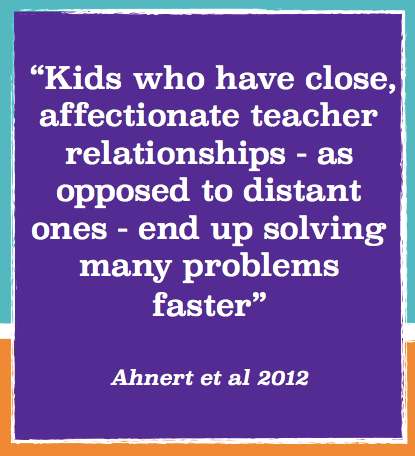Connecting with Each Kid in Your Class
As we begin a new school year, I know things are CRA-ZY! But don’t let the busyness of setting up your classroom and getting into new routines keep you from the most important part of your job…connecting with kids.
The Student-Teacher Relationship is Powerful
Children naturally attach with the adults in their lives. As one who spends a lot of time with your children, you have the opportunity to make connections that can make a positive and long-lasting differen ce.
ce.
Research shows that a secure, supportive child-teacher relationship is beneficial in many ways and can contribute to long-term academic achievement. These lucky children are likely to enjoy:
- Greater classroom engagement
- More social competence
- Increased language and cognitive development
- Emotional confidence
- Fewer behavior problems
- Increased readiness for kindergarten
Download the pdf: Helping kids get to know each other
Tips for Connecting with Young Children
In order to make a meaningful connection, get to know your children. Every child is unique and should be valued for who they are. Here are a few tips for how to connect with your children:
Be Present
Take the time to pause from tasks that demand your attention to just tune-in to a child. This one act will speak volumes to kids, who are often brushed off by adults who are too busy to be in the moment. Be mindful that children need caring adults to notice and take interest. Let them know they are worthy of your time and you care about what they do, say and think and that you enjoy hanging out with them.
 Physical Proximity
Physical Proximity
One powerful way to connect to a child is to be physically close. Get down on their level and interact with them face-to-face. Physical affection conveys warmth, care and love and can be demonstrated through hugs, pats on the back, knuckle bumps or high fives!
Conversation
This is super simple, but can often be missed. So much of our day is giving instructions, telling kids what to do and where to go, that we can miss opportunities for genuine connection through conversation. Be mindful of every child, making sure everybody gets some one-on-one with you. Taking the time to listen attentively is how we get to know others, and it shows that you are interested in them as a person.
Pay Attention!
One of the best ways to convey value and to connect with kids is to become a keen observer. In addition to learning where they are developmentally, ask yourself:
- How do they spend their time?
- What are their interests?
- How do they interact with others?
- What are their unique family dynamics?
- How do they learn best?
- What skills and talents do they possess?
- What upsets them?
The information you gain through observation can be jotted down and added to the child’s folder or portfolio, so you can use it for individualized planning and problem solving.
Download the PDF: Helping kids get to know each other
Ahnert L, Harwardt-Heinecke E, Kappler G, Eckstein-Madry T, and Milatz A. 2012. Student-teacher relationships and classroom climate in first grade: how do they relate to students’ stress regulation? Attach Hum Dev. 14(3):249-63
Badiyyah I. Waajid, 2005. The Relationship Between Preschool Children ‘ s School Readiness, Social-Emotional Competence and Student-Teacher Relationships Virginia Commonwealth University
Hamre BK and Pianta RC. 2001. Early teacher-child relationships and the trajectory of children’s school outcomes through eighth grade. Child Dev.72(2):625-38.
Hughes JN, Wu JY, Kwok OM, Villarreal V, and Johnson AY. 2012. Indirect Effects of Child Reports of Teacher-Student Relationship on Achievement. J Educ Psychol. 104(2):350-365. Epub 2011 Nov 21.
Rudasill KM, Reio TG Jr, Stipanovic N, and Taylor JE. 2010. A longitudinal study of student-teacher relationship quality, difficult temperament, and risky behavior from childhood to early adolescence. J Sch Psychol.48(5):389-412.
Schmitt MB, Pentimonti JM, and Justice LM. 2012. Teacher-child relationships, behavior regulation, and language gain among at-risk preschoolers. J Sch Psychol. 50(5):681-99.

